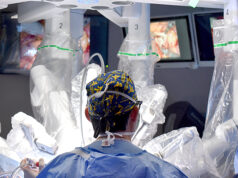
Emmanuel Messas (Hôpital Européen Georges Pompidou, Paris, France) and colleagues report in JACC: Basic to Translational Science that pulsed cavitation ultrasound can be used to remotely soften degenerative calcified biosprosthetic valves and significantly improve the valve opening function. They say that this new non-invasive approach has the potential to improve the outcome of patients with severe bioprosthesis stenosis.
In this study, Messas et al examined the effects of pulsed cavitational ultrasound on human bioprosthetic heart valves that were removed from patients because they were heavily calcified and were non-functional. Pulsed cavitational ultrasound—also called histotripsy—uses short-pulses of focused high pressure ultrasound to soften biological tissue. The ultrasound is delivered by a transducer that can be placed outside of the body and directed in a focused manner to the area of interest.
The removed valves were surgically implanted in sheep or were studied in an experimental bath apparatus in order to examine the longer-term effects of pulsed cavitational ultrasound. The researchers found the pulsed cavitational ultrasound was able to soften the stiff calcified valves and improve the function, or opening, of the valves. The amount of stenosis, or lack of opening, of the calcified aortic valves decreased by about two-fold on average in both the animal model and the experimental apparatus.
Messas says: “We believe that this novel ultrasound therapy could become a non-invasive therapeutic strategy in cardiology. This new non-invasive approach has the potential to improve the outcome of patients with severe calcified bioprosthesis stenosis by avoiding risky surgical or transcatheter reintervention.”
This study was designed as a proof of concept study and did not evaluate the potential risk of pulsed cavitational ultrasound causing pieces of the calcified aortic valve breaking off and causing an embolic stroke.













